AD 227 Exam 3 Key Works
1/26
There's no tags or description
Looks like no tags are added yet.
Name | Mastery | Learn | Test | Matching | Spaced |
|---|
No study sessions yet.
27 Terms
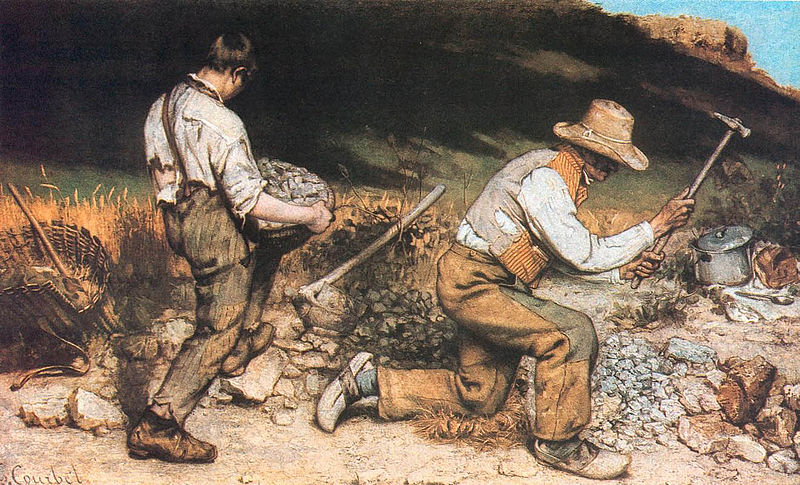
Gustave Courbet, The Stone Breakers.
France, 1849 [destroyed in 1945].
Realism. Oil on Canvas.
This realist painting depicts the backbreaking labor of stone breakers. Turning away from idealized representations of high subject matter and even the romanticization of low subject matter, the painting is objective and harsh just like the menial labor it depicts. Painted at history-painting scale, this Courbet challenges both the status quo of the artistic scene and of the sociopolitical landscape, drawing attention to the plight of the extremely poor who spend their entire lives in poverty as this painting suggests with its two figures.
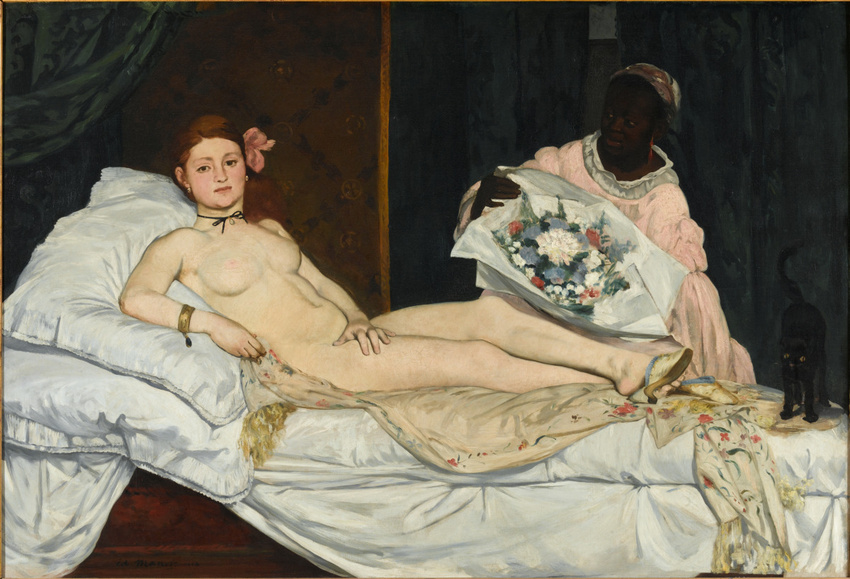
Édouard Manet, Olympia.
France, 1863.
Realism. Oil on Canvas.
While the classic female reclining nude had been a staple of art for centuries, the subject was always masked behind romanticized titles: either a “Venus” or an “Odalisque.” Manet rejects this; Olympia, a common name for a prostitute, lounges confidently while a black servant presents flowers she has received. While the painting references Titian’s Venus of Urbino, the bluntness of Manet’s subject in this painting created scandal among the art world.
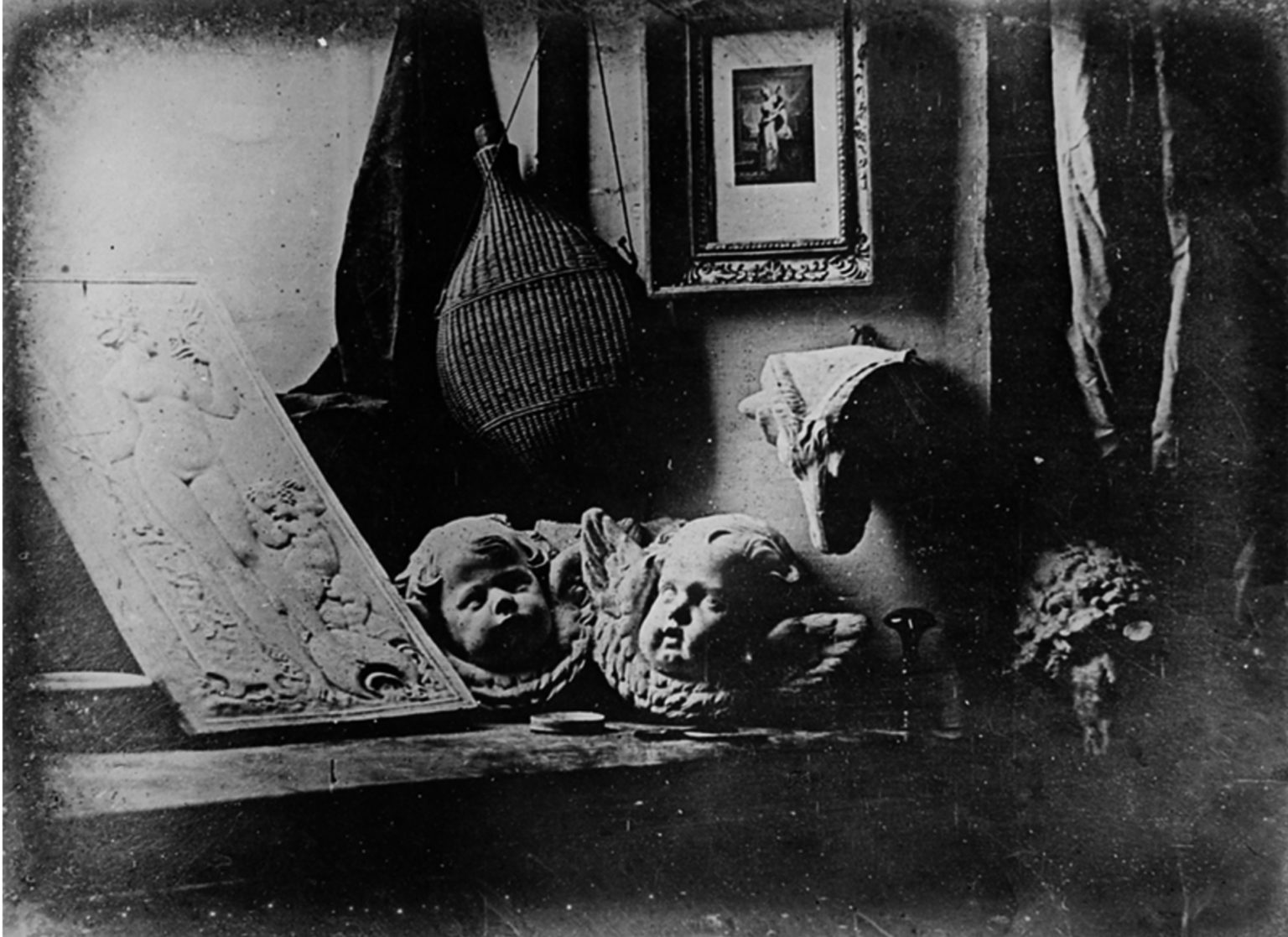
Louis-Jacques-Mandé Daguerre, Still Life in Studio.
France, 1837.
Early (Realist) Photography. Daguerreotype.
While not the first photograph, this image is the earliest surviving of Daguerre’s process, which improved over earlier prototypes to start becoming practical for taking images. While the exposure time was still long, still life was an option for taking photographs, creating the first foothold in the artistic world for the new technology.

Timothy O’Sullivan, A Harvest of Death, Gettysburg, Pennsylvania.
Pennsylvania, United States, 1863.
Early (Realist) Photography. Albumen Print.
The objectivity of photography made it the perfect tool for both realism and documentary. This image captured of the aftermath of the Battle of Gettysburg of the United States Civil War captures the grim outcome of the fighting, with lifeless, mutilated bodies strewn across the landscape. Photography captures the horror of war in extreme realism that packs an emotional punch.
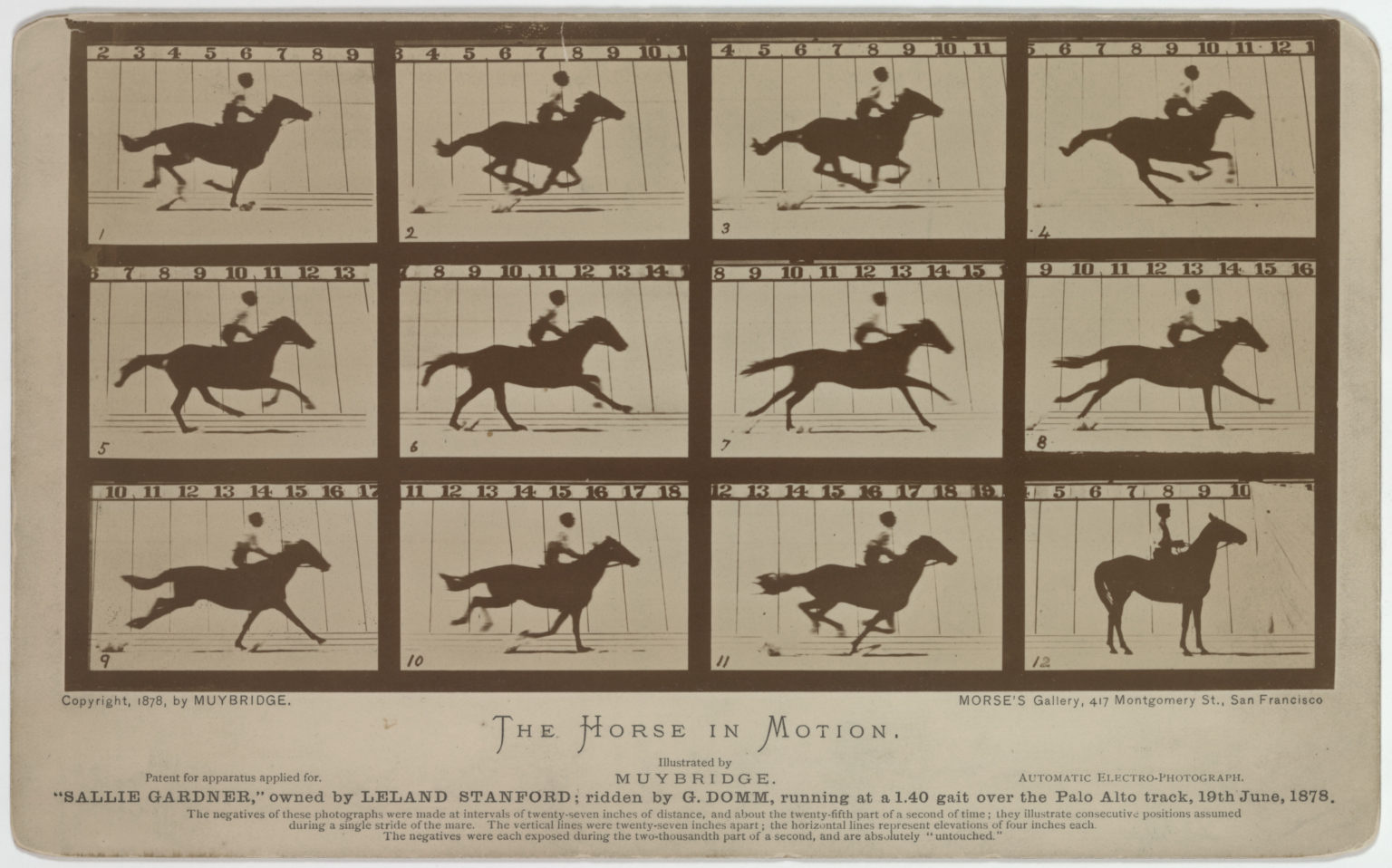
Eadweard Muybridge, Horse Galloping.
California, United States, 1878.
Early (Realist) Photography. Calotype Print.
With photography technology advancing to allow shorter exposure times and snapshots, cameras were set up to trigger along a horse track in order to settle a bet: do all of a horse’s legs leave the ground in a gallop? While finding the answer to be yes, the result also produced a photographic animation when viewed in series, creating the start of film cinema.
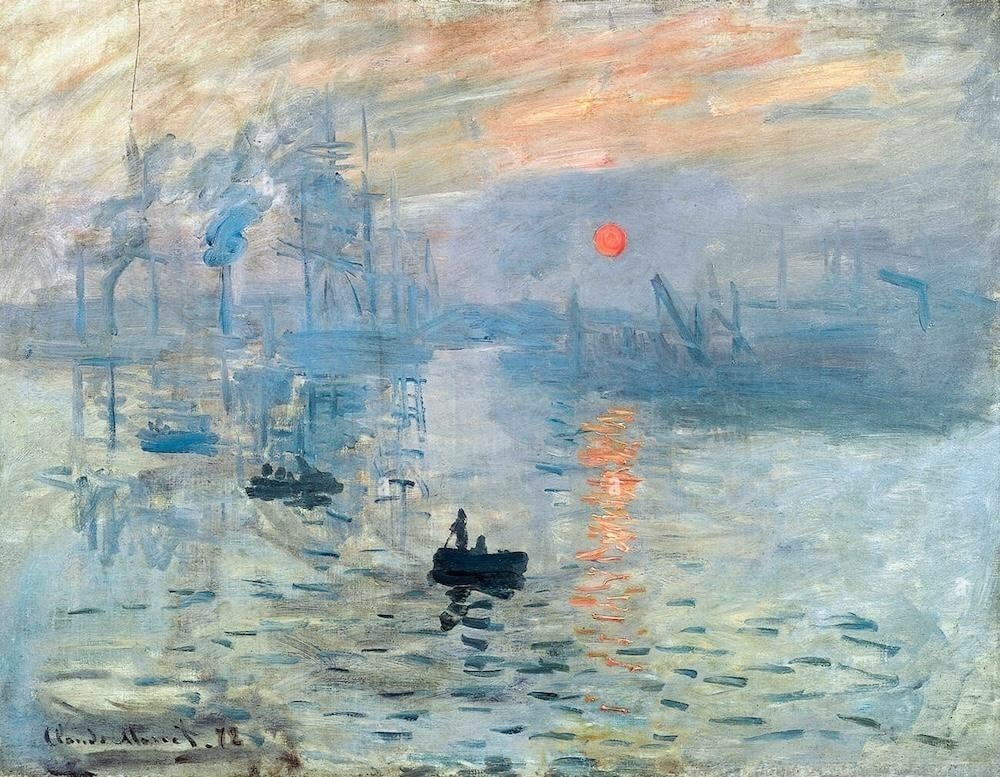
Claude Monet, Impression: Sunrise.
France, 1872.
Impressionism. Oil on Canvas.
In the piece giving the Impressionist movement its name, this sketchy painting “impression” captures the visual experience of a sunrise out on the water by waterside docks. Tube paint technology allowed for Monet to create these paintings quickly en plein air and capture the visual experience of light and atmospherics while deviating from strict illusionism through rendering and perspective characteristic of prior movements. This new approach to painting was not immediately well-received, with many seeing this finished work as an unfinished sketch.
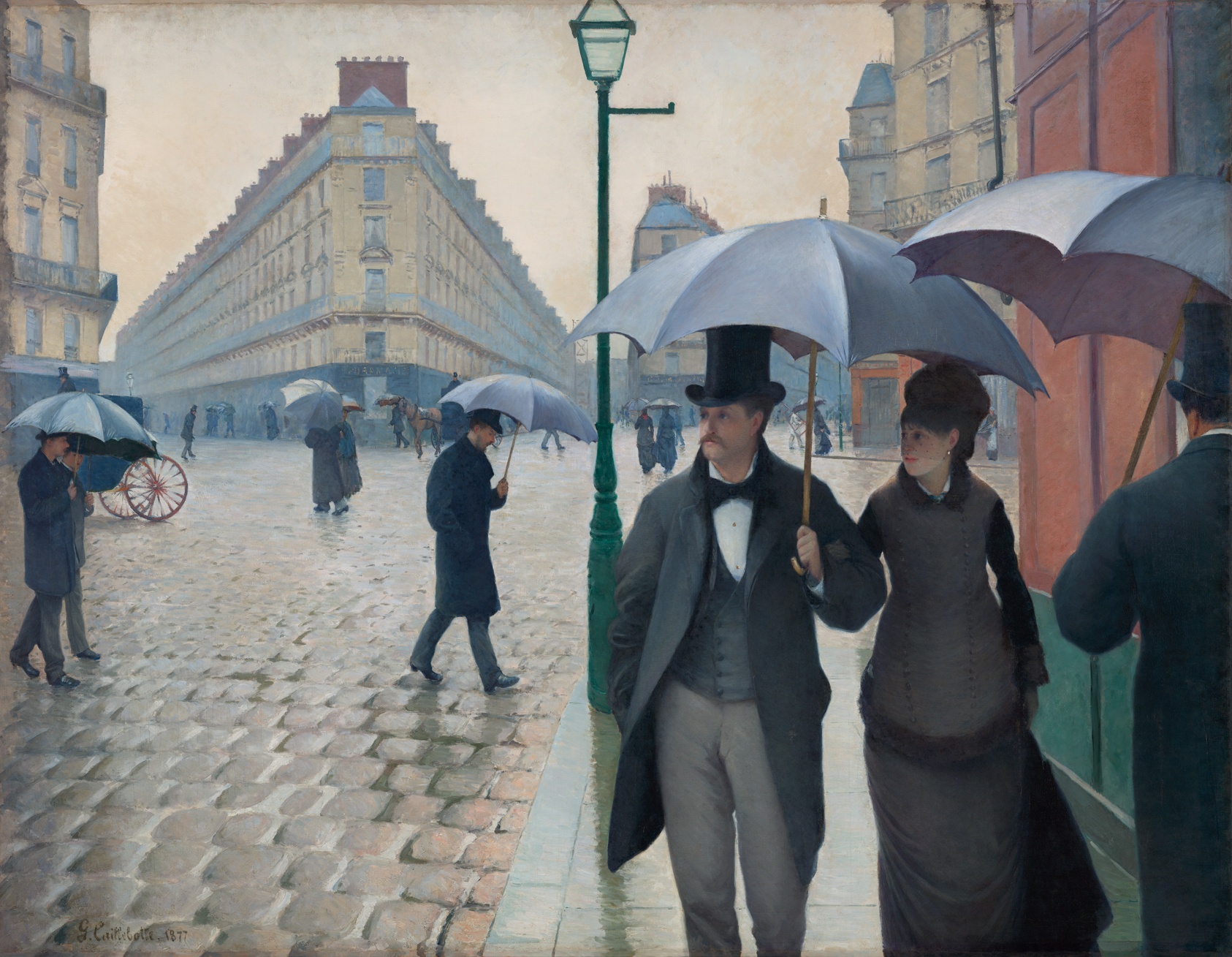
Gustave Caillebotte, Paris: A Rainy Day.
France, 1877.
Impressionism. Oil on Canvas.
While this painting follows illusionistic rendering and perspective unlike Monet’s work, it is still Impressionistic in its subject matter. The painting captures a moment passing by: Parisians walk the streets as rainfall is clearing up, the painting captures the motion and changes of 19th century life.
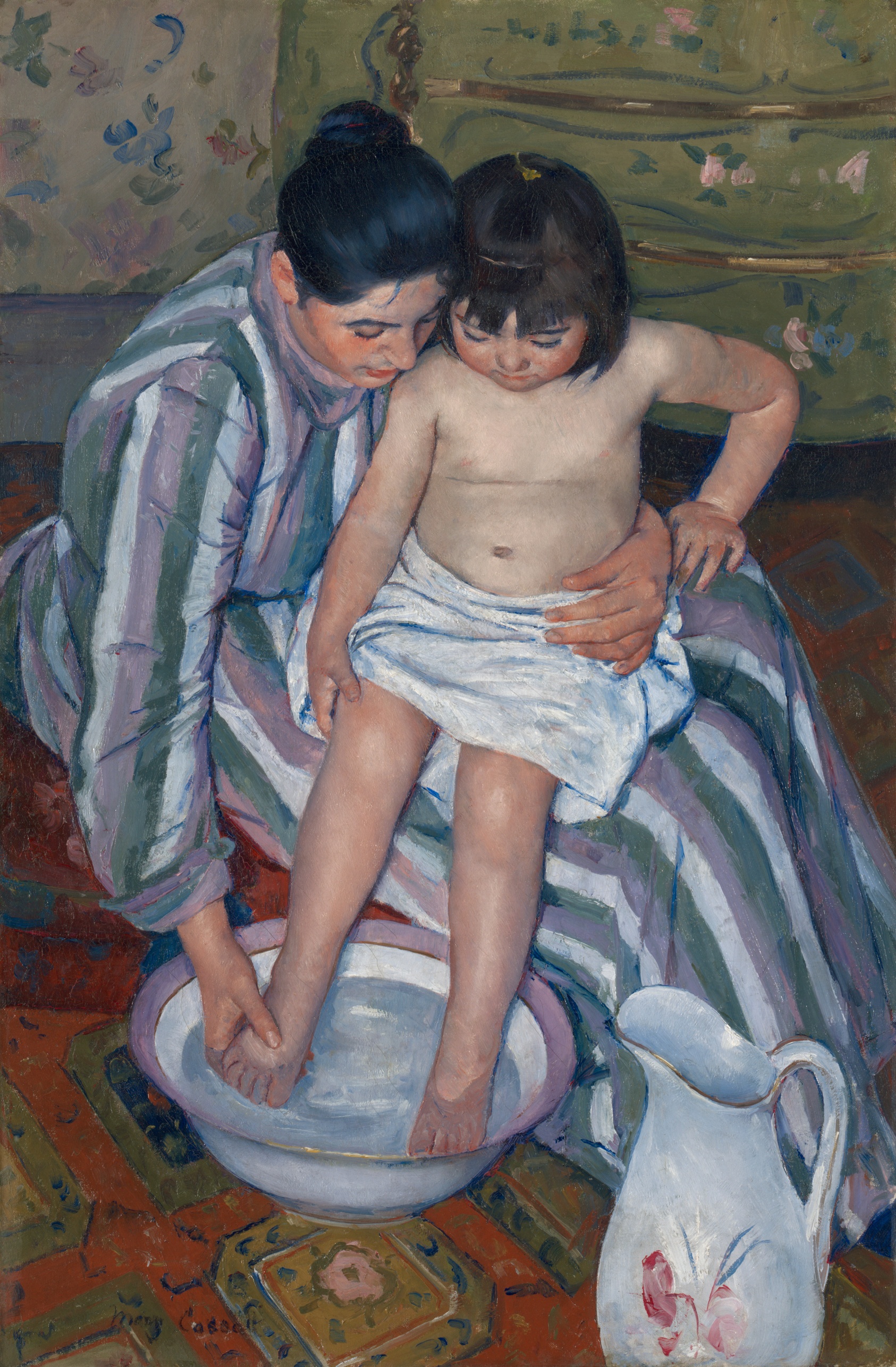
Mary Cassatt, The Child’s Bath.
France, 1893.
Impressionism. Oil on Canvas.
While this Impressionist piece possesses traditional illusionistic rendering, the perspective is unusual and awkward, taking a steep view looking downwards, a trend drawn from Japanese art that was being imported around the time.
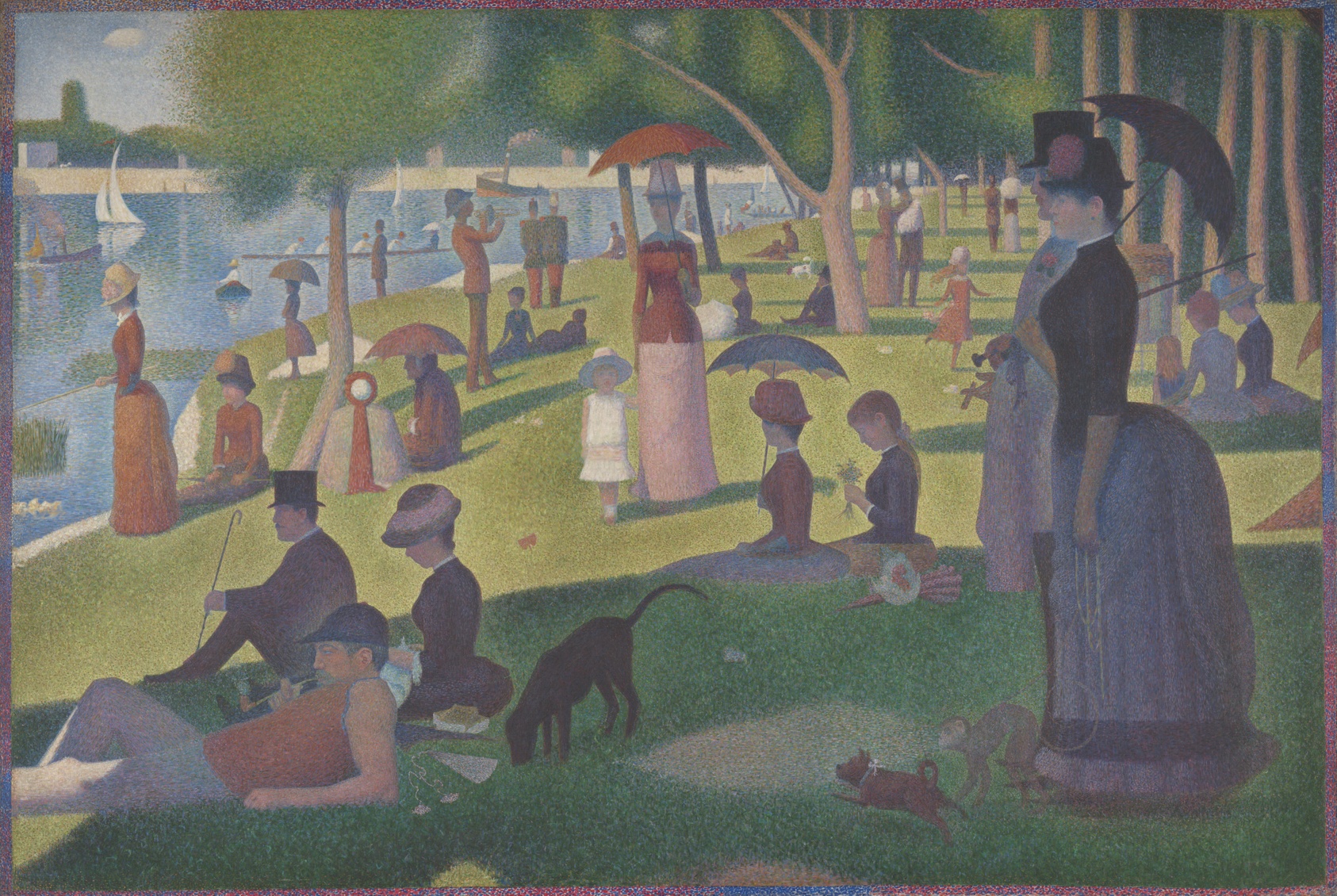
Georges Seurat, A Sunday on La Grande Jatte.
France, 1884–1886.
Post-Impressionism (Pointillism). Oil on Canvas.
Others following the Impressionists were interested in similar subjects but wanted to explore new techniques in their painting. Seurat utilizes the principle of optical mixture to paint in tiny dots which blend into hues, shades, and tones from afar, constructing an image snapshot of a crowd enjoying their day along the riverside.
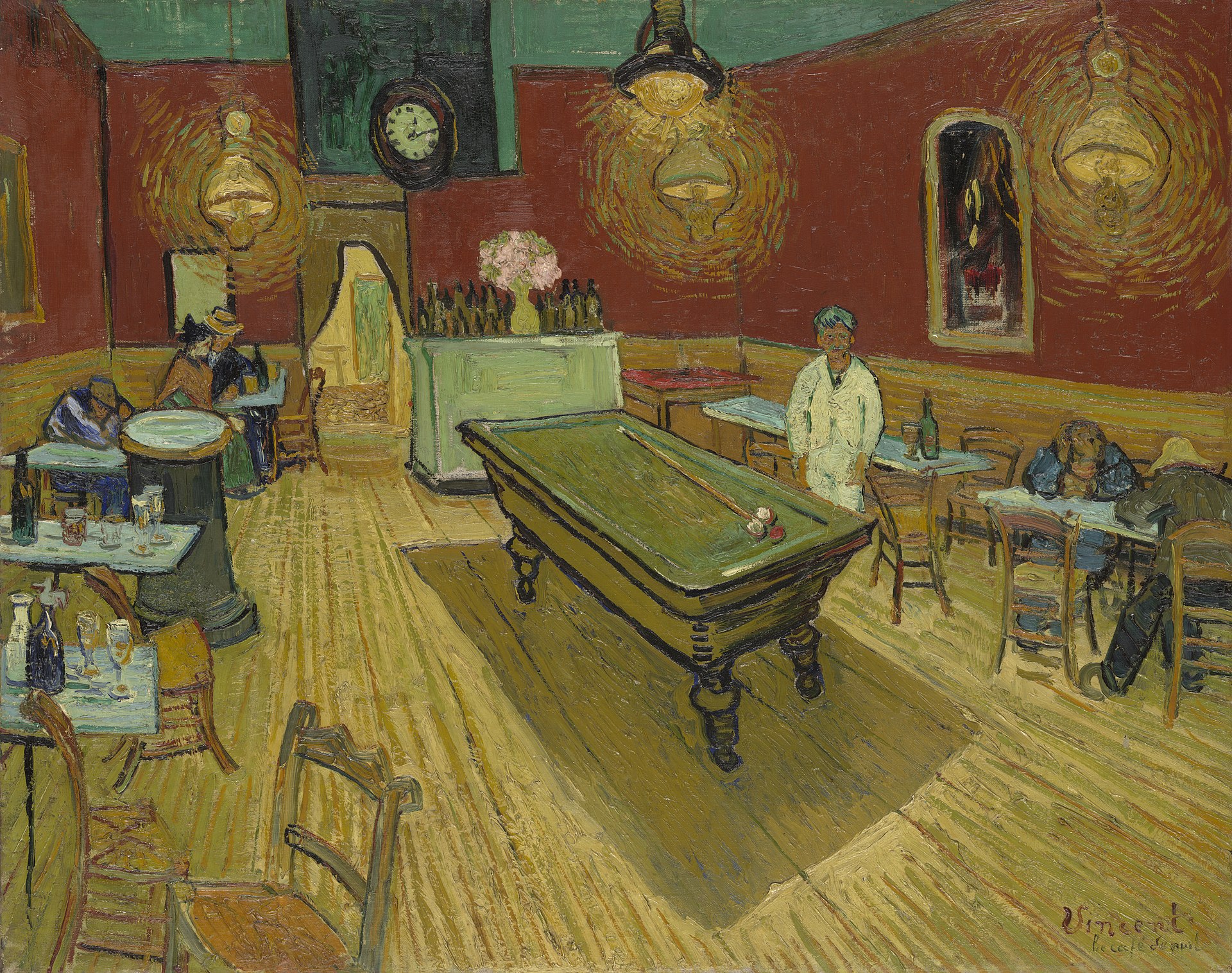
Vincent van Gogh, Night Café.
France, 1888.
Post-Impressionism. Oil on Canvas.
Painted with bright warm colors and thick, gestural brushwork, the painting still gives off discomforting vibes due to the precarious perspective, sickly colors, and hunched figures. van Gogh is able to capture both aspects of his mental state and the seedy nature of the night cafe through his painting by emphasizing the emotions of color and composition over real world appearance.

Paul Cézanne, Basket of Apples.
France, ca. 1895.
Post-Impressionism. Oil on Canvas.
Cézanne’s painting focuses on exploring the observation of a still-life table through color and misshapen perspective. The colors and shading of objects are not fully abstracted, but broken down into larger patches of colors blocking out the light and shade that is seen by the viewer. The objects in the image do not follow a consistent perspective, even among themselves. Broken lines and tilted perspective create an impression of walking all around the table while viewing it.
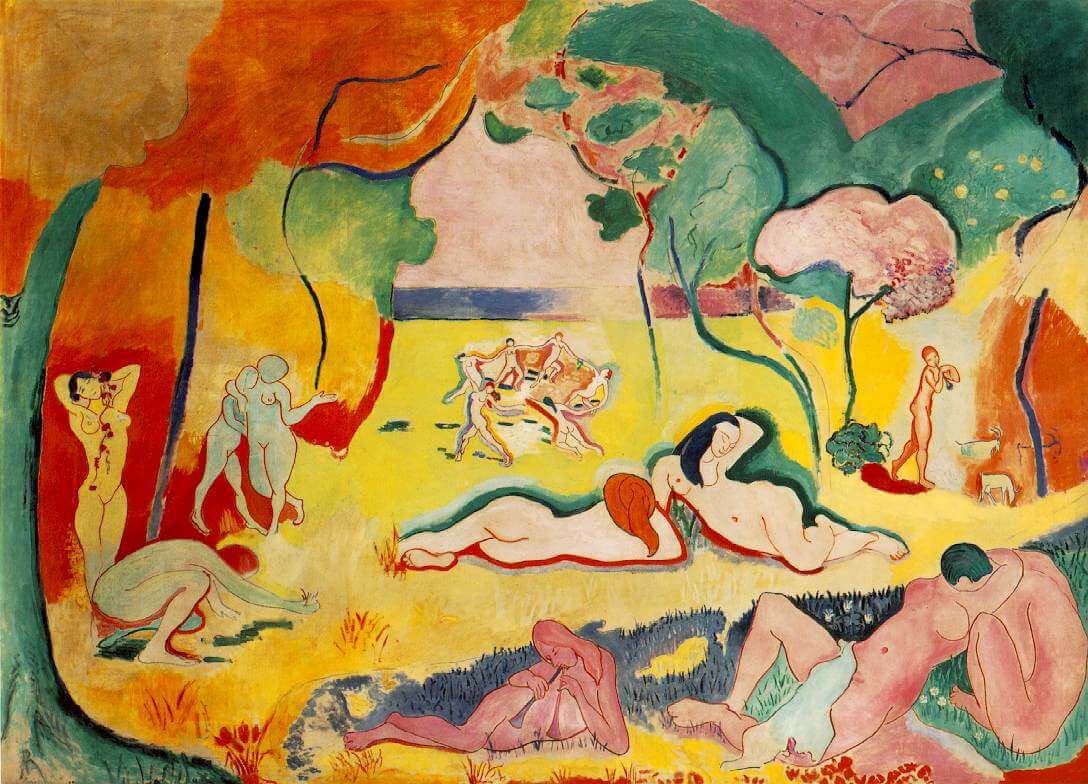
Henri Matisse, Le Bonheur de Vivre (The Joy of Life).
France, 1905–1906.
Fauvism (Modernism). Oil on Canvas.
Consisting of bold colors with simple, distorted, and abstract shapes characteristic of Fauvism, this painting explores new forms of visual expression for traditional subject matter: nude figures or bathers. With no concrete narrative, the painting assembles lumpy and colorful figures defying perspective amid a similarly abstracted forest grove background.
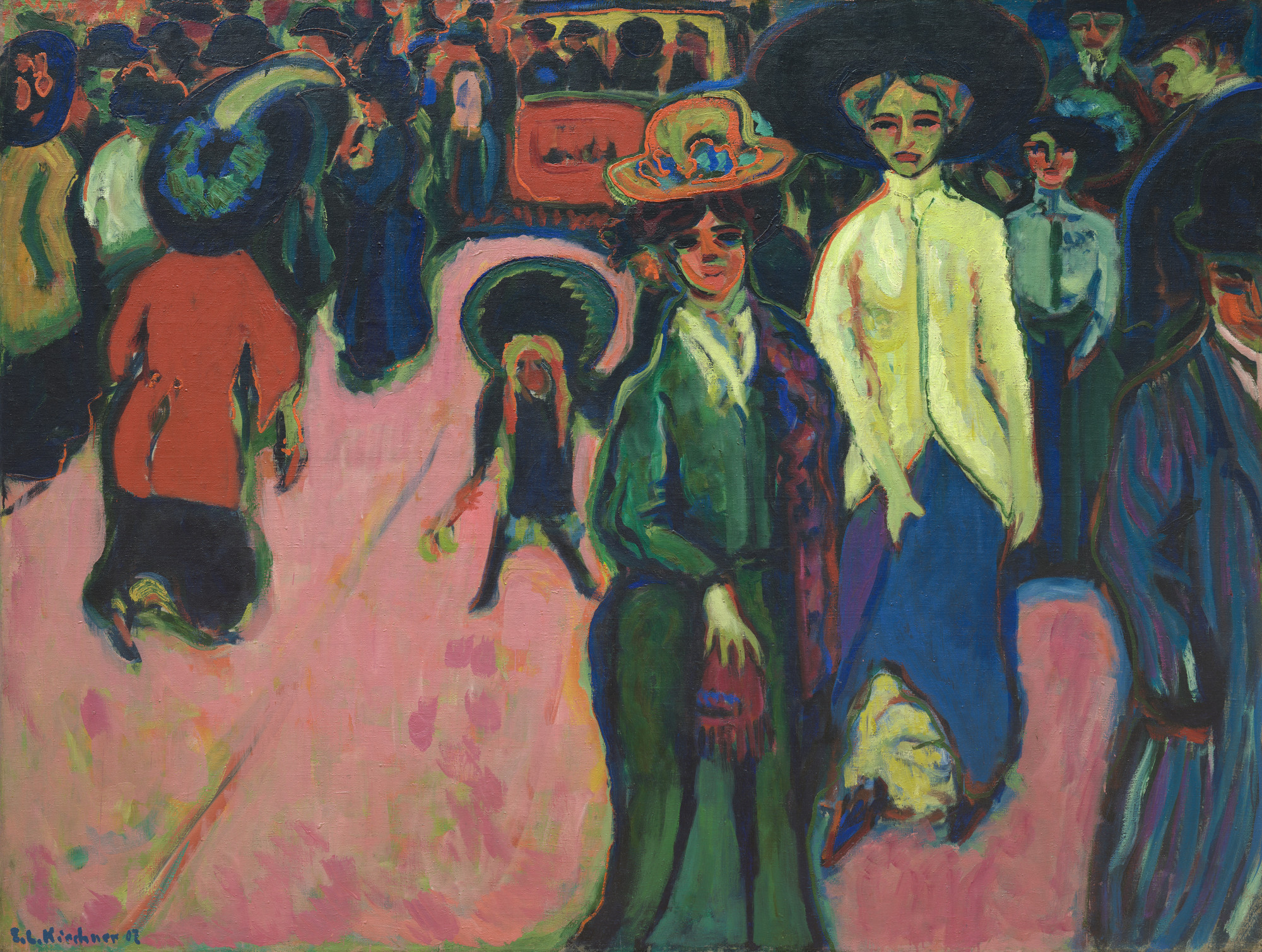
Ernst Ludwig Kirchner, Street, Dresden.
Germany, 1908.
German Expressionism (Modernism). Oil on Canvas.
With the fast-paced changes of the modern world outpacing the people in society, especially in Germany lagging the industrial revolution, members of the artistic group Die Brücke expressed the emotions of time through angsty paintings. Uncanny figures, scenery, and colors create a sense of alienation and of dizzying nausea from being on a busy street in a fast moving world.
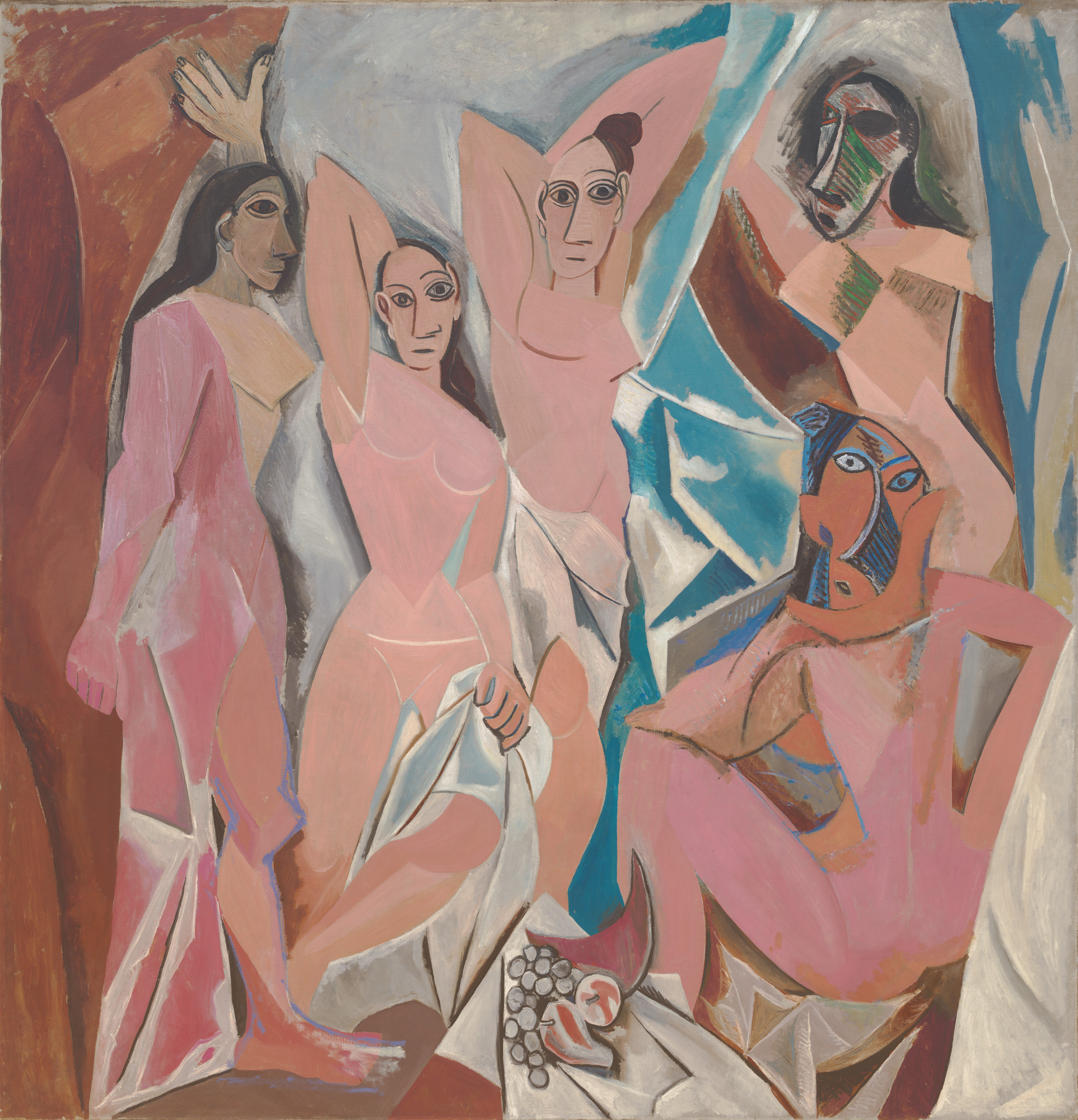
Pablo Picasso, Les Demoiselles d’Avignon.
France, 1907.
Analytic Cubism (Modernism). Oil on Canvas.
While the subject matter may be somewhat traditional, nude figures (prostitutes), Picasso develops the signature visual display technique: any depth and rendering is flattened into planes of color, removing any separation between subject and background other than color alone. Drawing from aboriginal art and Cézanne, the figures’ features are viewed from all angles simultaneously, resulting in jumbled forms and faces.
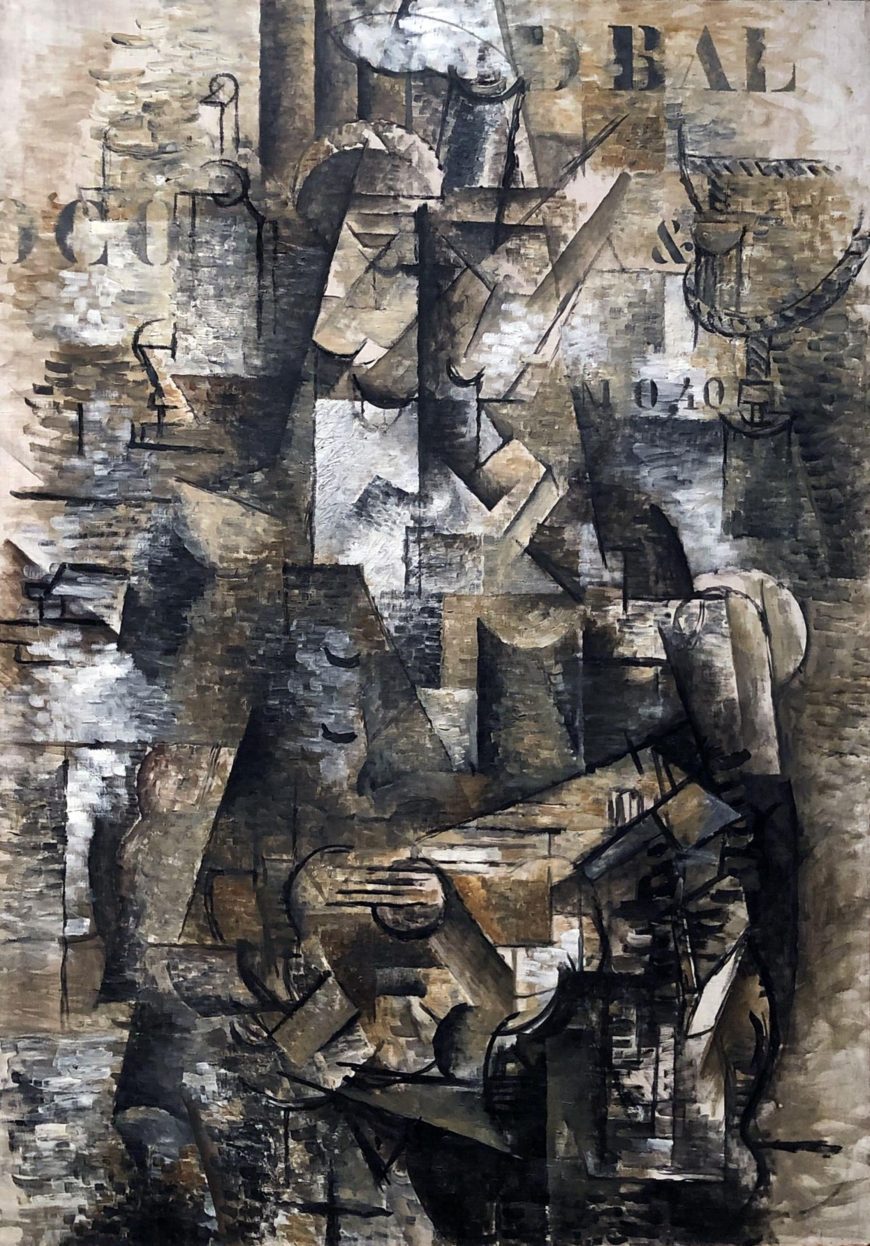
Georges Braque, The Portuguese.
France, 1911.
Analytic Cubism (Modernism). Oil on Canvas.
An abstract and cubist portrait of a Portuguese musician, hints o fa face, form, and instrument emerge from earthy tones of flat shapes. While the figure is decomposed in the cubist style, printed words and characters are also added to the image beginning to draw elements of Synthetic Cubism that would be developed later.
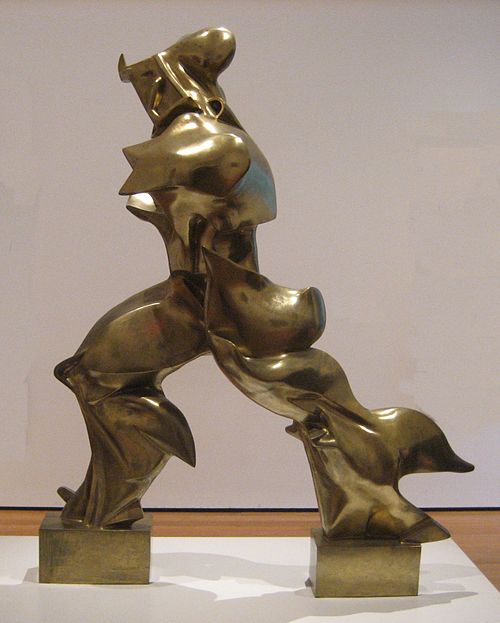
Umberto Boccioni, Unique Forms of Continuity in Space.
Italy, 1913.
Futurism (Modernism). Bronze Sculpture.
Following the Futurist fascination with the speed and dynamism of the modern age, this sculpture broadly depicts a figure powerfully striding through space. The form is composed of Cubist-like geometry and shapes rather than a realistic human form. The combination of hard edges and flowing curves further reinforce a sense of dynamism and unstoppable impelling force.
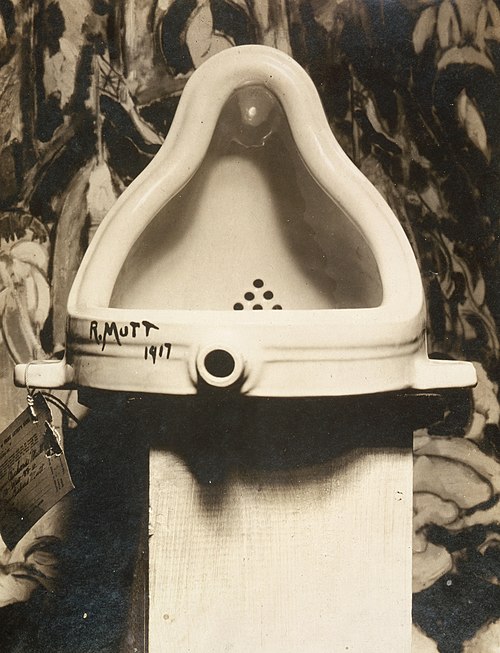
Marcel Duchamp, Fountain.
France, 1917.
Dada Readymade (Modernism). Glazed sanitary china with black paint.
A urinal repurposed as artistic piece with minimal adaptation, the work is simultaneously a serious artistic piece and critique of contemporary conceptions of art. The quirky and satirical nature of the piece are right in line with the Dada movement and Absurdist philosophy.
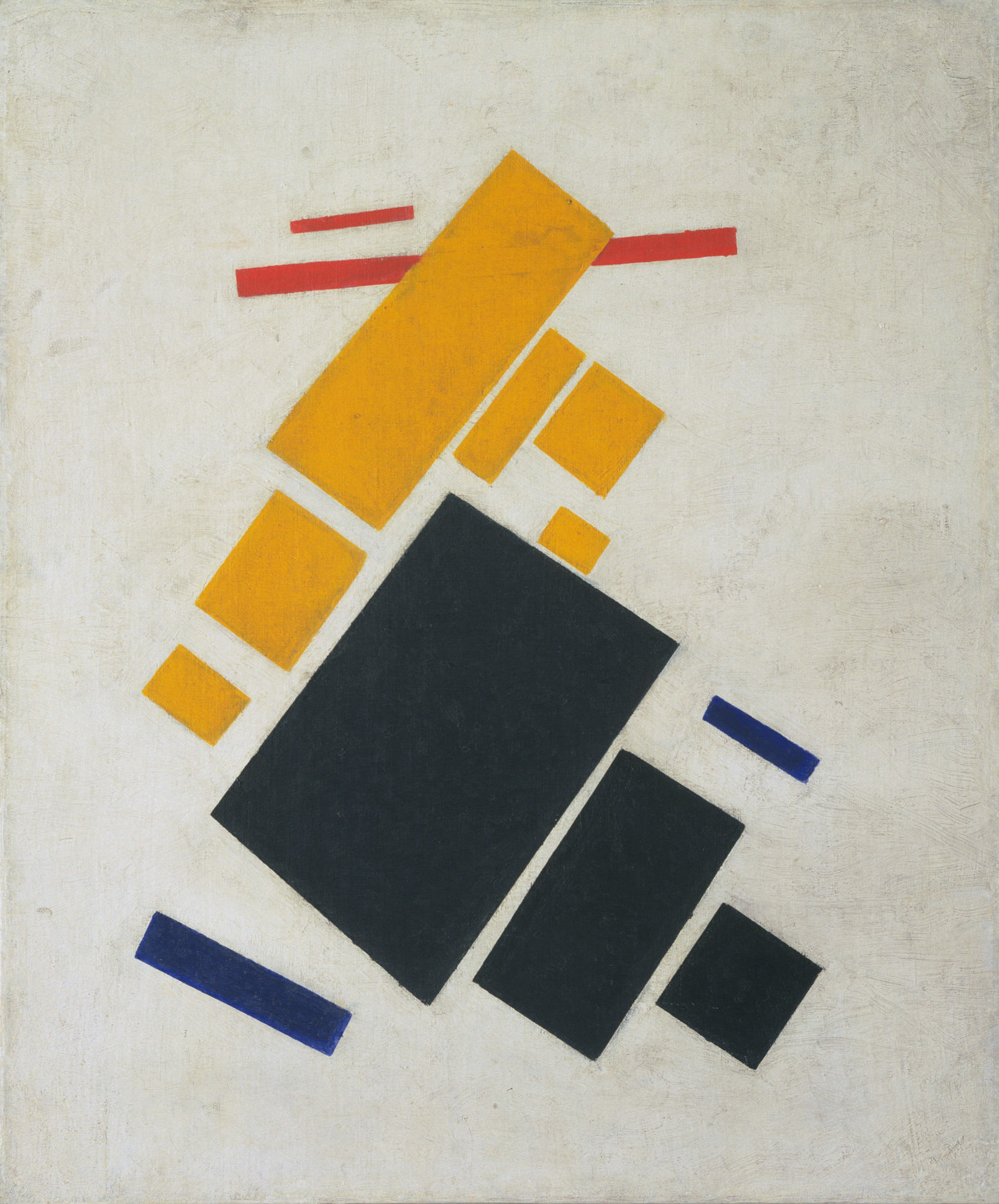
Kazimir Malevich, Suprematist Composition: Airplane Flying.
Russia, 1915.
Suprematisim (Modernism). Oil on Canvas.
Having hit pure abstraction, this piece does not depict a subject beyond some sense of altitude, speed, and levitation. A Sumprematist piece seeks only to depict the painting as a painting, utilizing pure color and geometric shape: art itself is superior to any subject it may depict, therefore painting should only represent itself, no illusions.
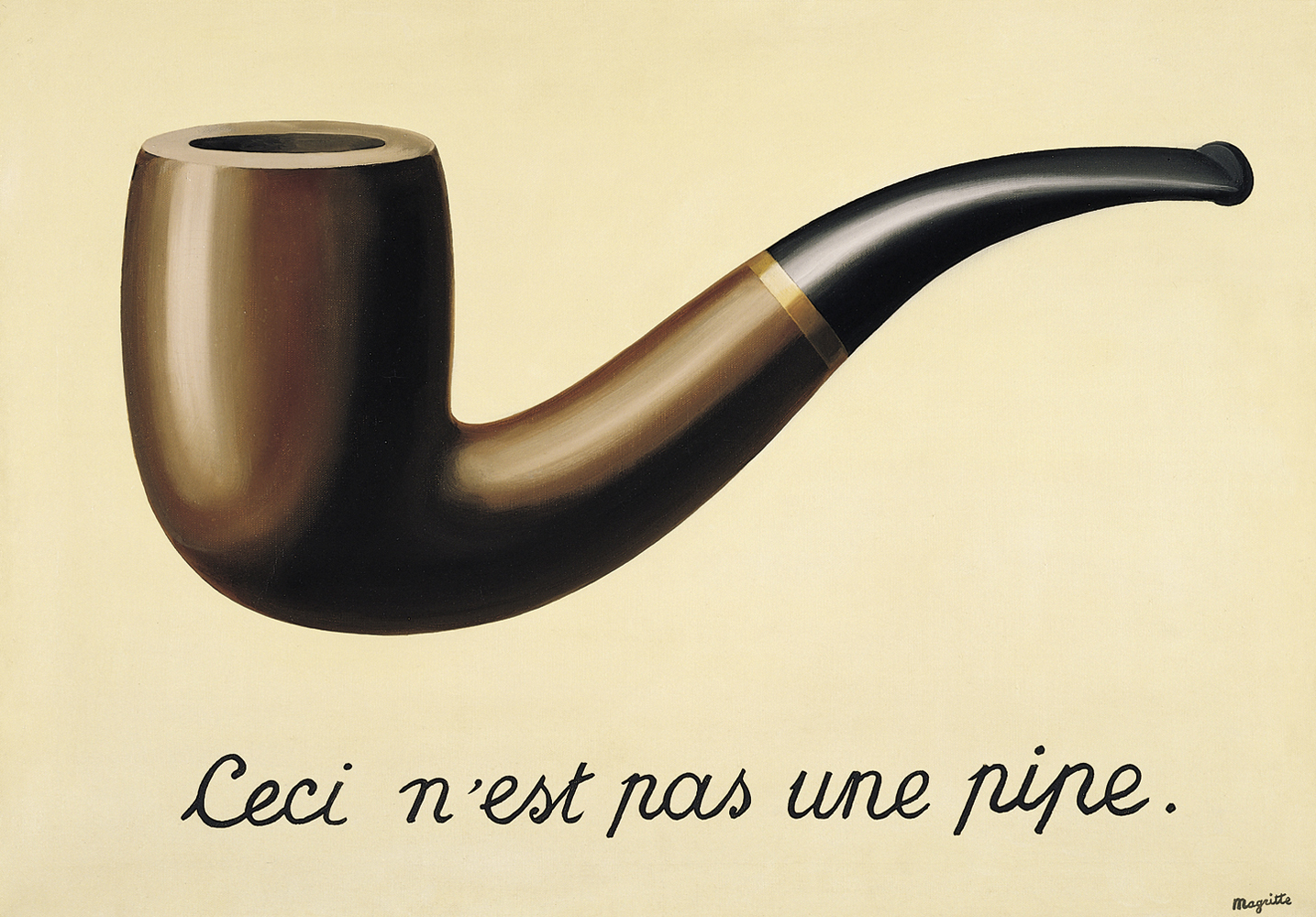
René Magritte, The Treachery (or Perfidy) of Images.
France, 1928–1929.
Surrealism (Modernism). Oil on Canvas.
Exploring the nature of thoughts, ideas, and reality, this painting reminds the viewer that a painting of a pipe is not itself a pipe.
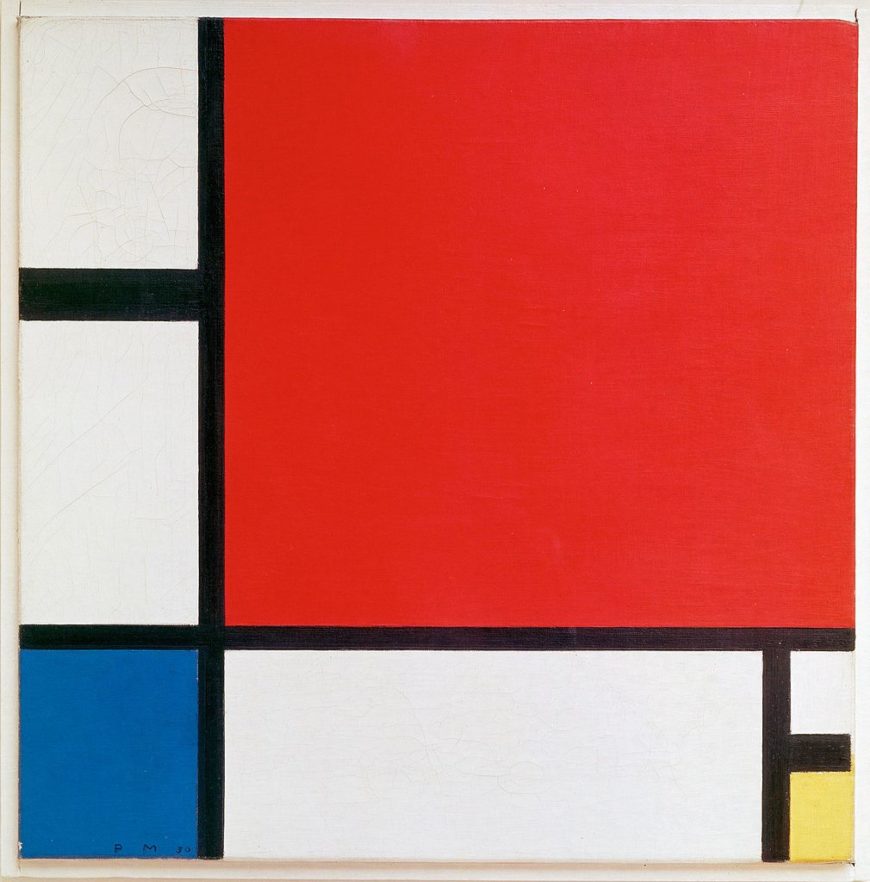
Piet Mondrian, Composition with Red, Blue, and Yellow.
Netherlands, 1930.
Neo-Plasticism/De Stijl (Modernism). Oil on Canvas.
Expressing purity in art and design, this painting only includes primary colors, primary shades, and primary directions. The robustness of this restricted form of art and design captures a concept of “The Style,” singular, of idealized abstract art.
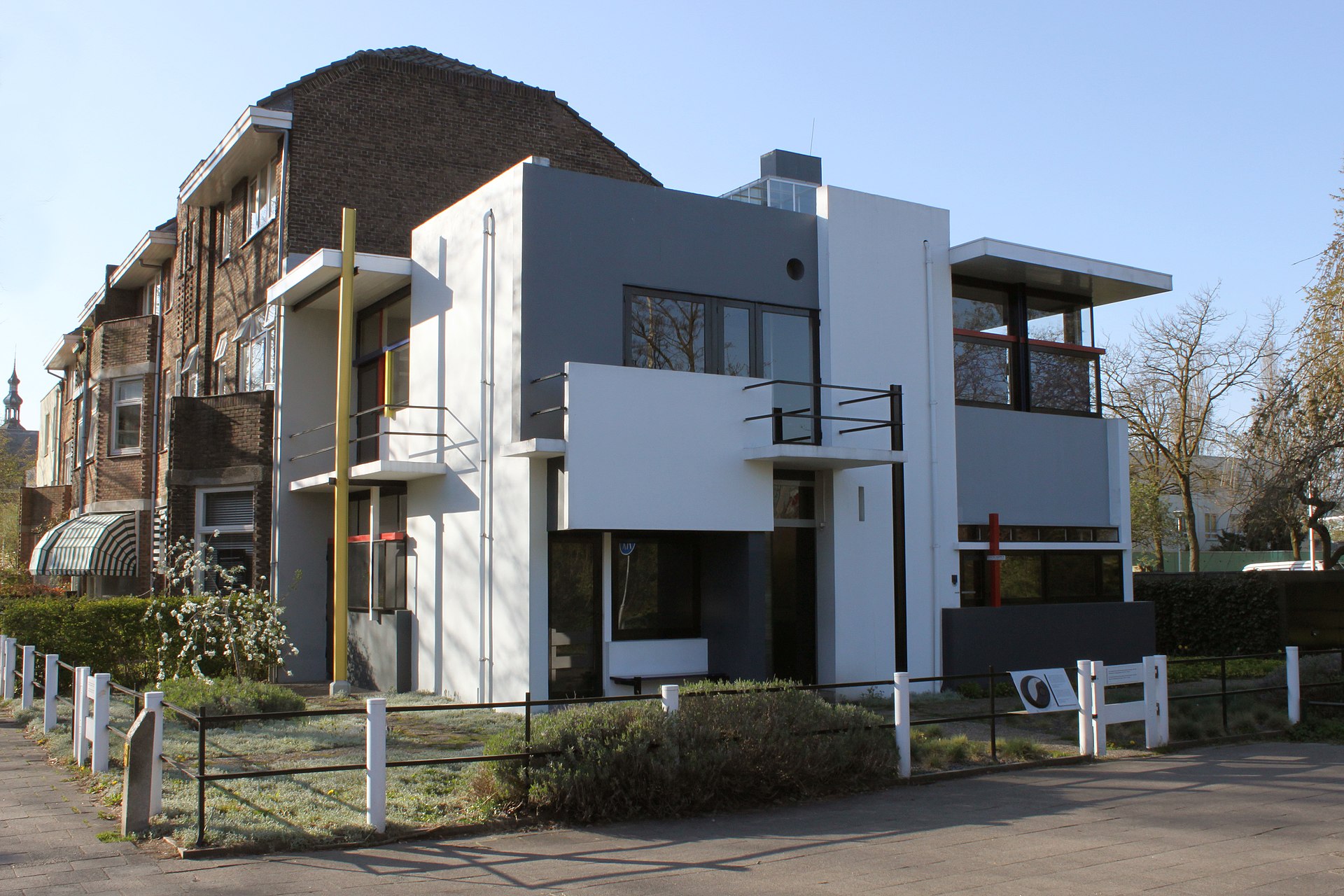
Gerrit Thomas Rietveld, Schröder House.
Utrecht, the Netherlands, 1924.
Neo-Plasticism/De Stijl (Modernism). Architecture.
Ideals about purity in art through primary colors, shades, and forms from The Style were applicable beyond just painting to all forms of art, design, and architecture. This house consists of white cuboids accented by black, red, yellow, and blue rectangular highlights.
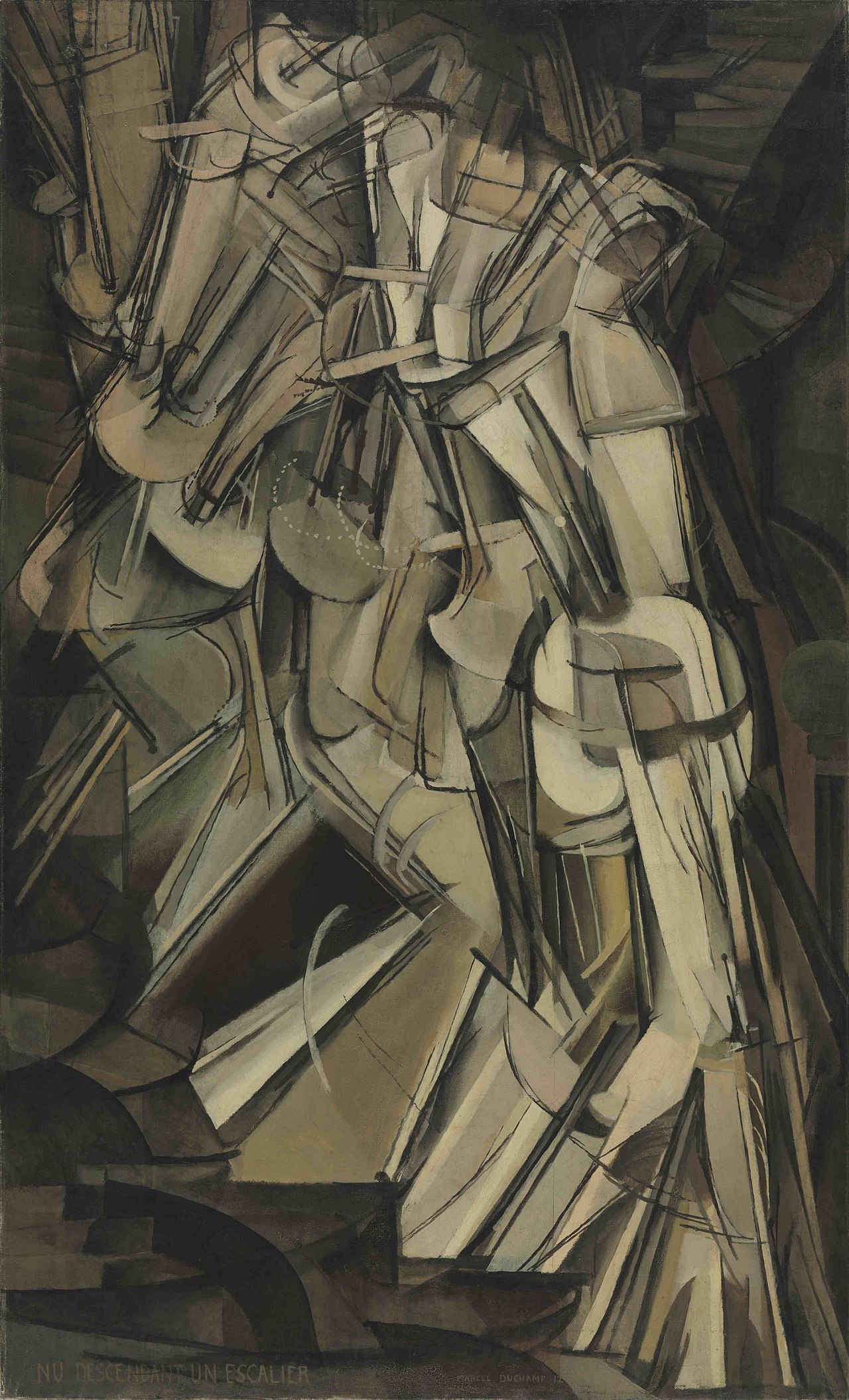
Marcel Duchamp, Nude Descending a Staircase, No. 2.
Painted France, 1912. Exhibited New York, United States, Armory Show, 1913.
American Modernism. Oil on Canvas.
Somewhere between Cubism and Futurism, this piece when exhibited at the Armory Show in New York in 1913 was part of a major introduction of the United States to artistic innovations occurring overseas.
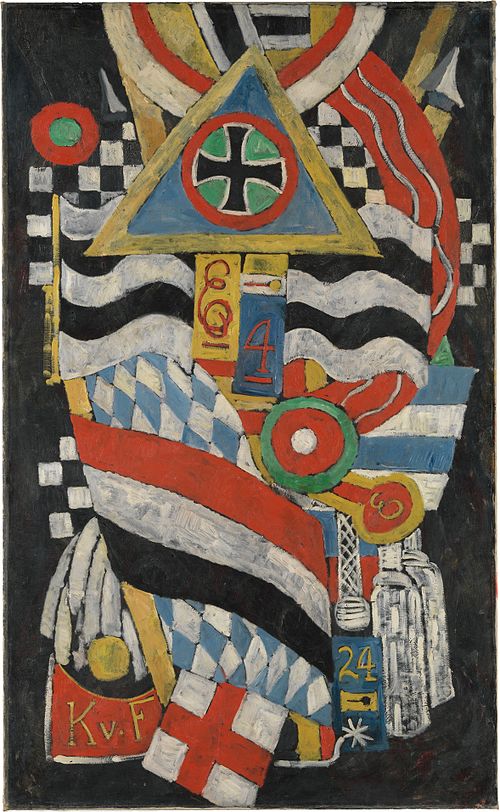
Marsden Hartley, Portrait of a German Officer.
Artist from United States. Painted Germany, 1914.
Synthetic Cubism (American Modernism). Oil on Canvas.
Hartley was inspired by the art he found upon moving to Germany. With the loss of his lover and German officer in World War I, this collage-like painting of military paraphernalia rendered in flat colors honors the man through references and symbols of his life as a soldier.
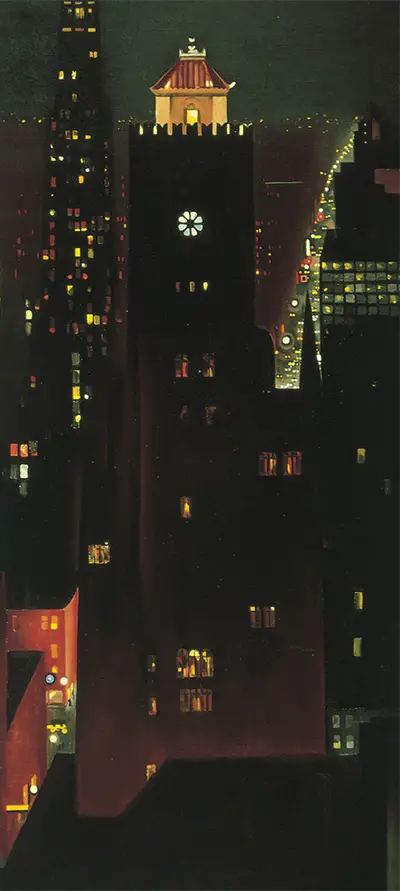
Georgia O’Keeffe, New York, Night.
New York, United States, 1929.
Precisionism (American Modernism). Oil on Canvas.
The New York City skyline is a powerful subject representative of modern life and a subject of many artistic works. O’Keeffe paints a skyscraper in flat, dark shades with crisp, precise lines and geometry making up the composition.
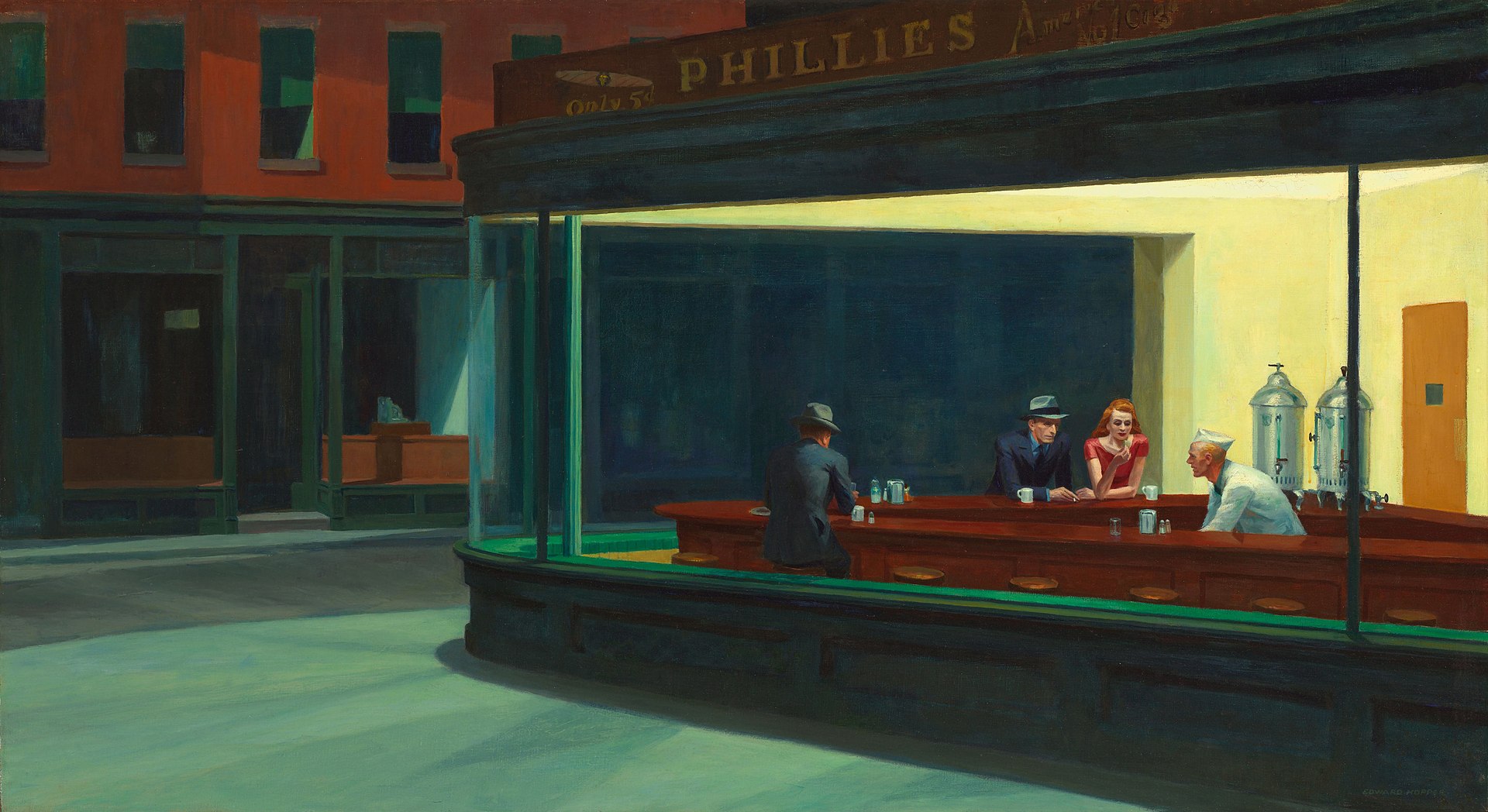
Edward Hopper, Nighthawks.
United States, 1942.
Regionalism (American Modernism). Oil on Canvas.
The aftermath of the Great Depression resulted in a return to realism in the United States. This painting depicts an almost eerie moment as a few figures inhabit a diner on a deserted street. The cold attitude emanating from the people in the painting exudes a feeling of depressive loneliness of the time.
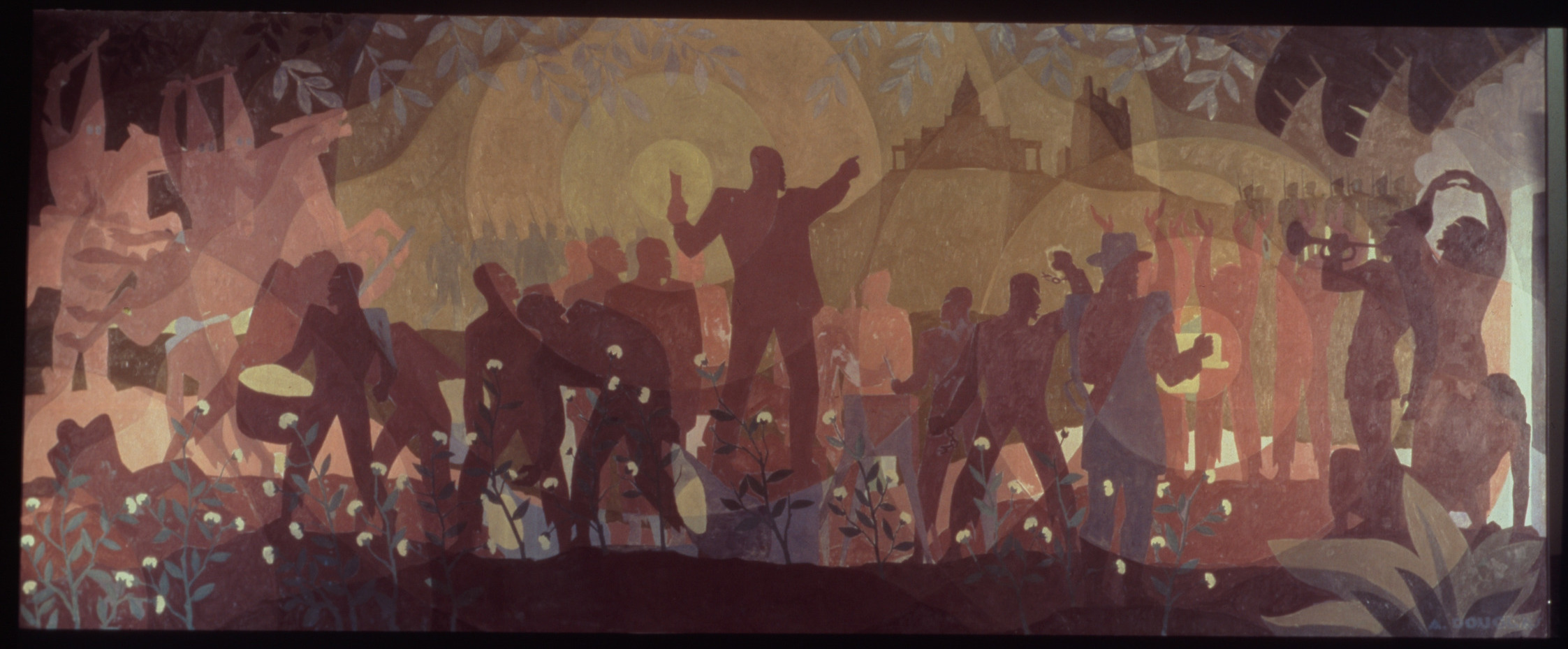
Aaron Douglas, From Slavery through Reconstruction, from Aspects of Negro Life.
New York Public Library, United States, 1934.
Harlem Renaissance (American Modernism). Oil on Canvas.
Funded by the Works Progress Administration through the Federal Arts Project, this painting depicts African American emancipation and the reconstruction. Figures are rising from a cotton field, breaking their chains. Two figures hold glowing law bills while pointing to a capitol building. Freed slaves are celebrating through song and dance, while hooded Klansmen ride in symbolizing the imperfection of the reconstruction.

Diego Rivera, Ancient Mexico, detail of History of Mexico.
Palacio Nacional, Mexico City, 1929–1935
Mexican Modern Art. Fresco.
Painted following the Mexican Revolution, the mural in the Mexican capitol depicts their history from ancient times to the modern day.